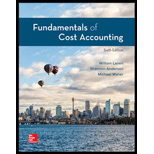
Concept explainers
a.
Ascertain the unit cost for each of the three jobs started and completed using the current costing system.
a.
Explanation of Solution
Activity-based costing:
Activity-based costing refers to the method of costing where the
Ascertain the unit cost for each of the three jobs started and completed using the current costing system:
Using the machine-hours, the predetermined rate using the traditional system is calculated. $80 per machine hour
Using the traditional system, the cost of each of the jobs are:
| Particulars | Job 0404 | Job 0407 | Job 0411 |
| Direct materials | $30,000 | $56,000 | $100,000 |
| Overhead (@$80%) | 128,000 | 160,000 | 320,000 |
| Total cost | $158,000 | $216,000 | $420,000 |
| Number of units | 1,000 | 1,200 | 2,000 |
| Unit cost | $158 | $180 | $210 |
Table: (1)
Working Note (1):
Calculate the overhead for Job 0404.
Hence, the unit cost for each of the three jobs started and completed are $158, $180, and $210, respectively.
b.
Ascertain the unit cost for each of the three jobs started and completed using the ABC system.
b.
Explanation of Solution
Compute the unit product cost:
| Particulars | Job 0404 | Job 0407 | Job 0411 |
| Direct materials | $30,000 | $56,000 | $100,000 |
| Overhead: | |||
| Material handling | 15,000(2) | 28,000 | 50,000 |
| Machining | 48,000(3) | 60,000 | 120,000 |
| Finishing | 16,000(4) | 19,200 | 32,000 |
| Shipping | 15,000(5) | 30,000 | 15,000 |
| Setups | 20,000(6) | 60,000 | 20,000 |
| Total costs | $144,000 | $253,200 | $337,000 |
| Number of units | 1,000 | 1,200 | 2,000 |
| Unit cost | $144.00 | $211.00 | $168.50 |
Table: (2)
Working Note (2):
Calculate the material handling overhead.
Working Note (3):
Calculate the machining overhead.
Working Note (4):
Calculate the Finishing overhead.
Working Note (5):
Calculate the Shipping overhead.
Working Note (6):
Calculate the Setups overhead.
Working Note (7):
Calculate the proportion of direct material cost.
Working Note (8):
Calculate the cost per machine-hour.
Working Note (9):
Calculate the cost per unit.
Working Note (10):
Calculate the cost per order.
Working Note (11):
Calculate the cost per run.
Want to see more full solutions like this?
Chapter 9 Solutions
Loose-leaf For Fundamentals Of Cost Accounting

 AccountingAccountingISBN:9781337272094Author:WARREN, Carl S., Reeve, James M., Duchac, Jonathan E.Publisher:Cengage Learning,
AccountingAccountingISBN:9781337272094Author:WARREN, Carl S., Reeve, James M., Duchac, Jonathan E.Publisher:Cengage Learning, Accounting Information SystemsAccountingISBN:9781337619202Author:Hall, James A.Publisher:Cengage Learning,
Accounting Information SystemsAccountingISBN:9781337619202Author:Hall, James A.Publisher:Cengage Learning, Horngren's Cost Accounting: A Managerial Emphasis...AccountingISBN:9780134475585Author:Srikant M. Datar, Madhav V. RajanPublisher:PEARSON
Horngren's Cost Accounting: A Managerial Emphasis...AccountingISBN:9780134475585Author:Srikant M. Datar, Madhav V. RajanPublisher:PEARSON Intermediate AccountingAccountingISBN:9781259722660Author:J. David Spiceland, Mark W. Nelson, Wayne M ThomasPublisher:McGraw-Hill Education
Intermediate AccountingAccountingISBN:9781259722660Author:J. David Spiceland, Mark W. Nelson, Wayne M ThomasPublisher:McGraw-Hill Education Financial and Managerial AccountingAccountingISBN:9781259726705Author:John J Wild, Ken W. Shaw, Barbara Chiappetta Fundamental Accounting PrinciplesPublisher:McGraw-Hill Education
Financial and Managerial AccountingAccountingISBN:9781259726705Author:John J Wild, Ken W. Shaw, Barbara Chiappetta Fundamental Accounting PrinciplesPublisher:McGraw-Hill Education





